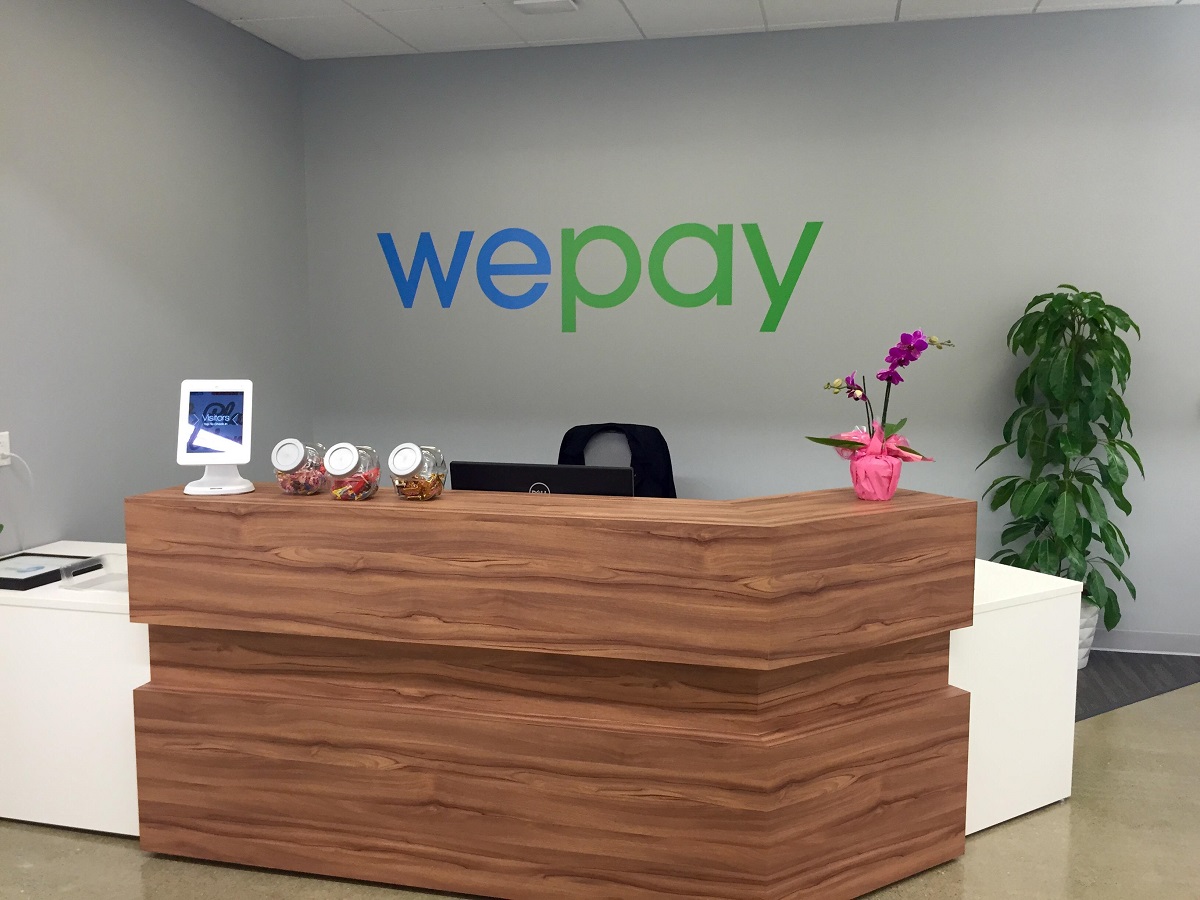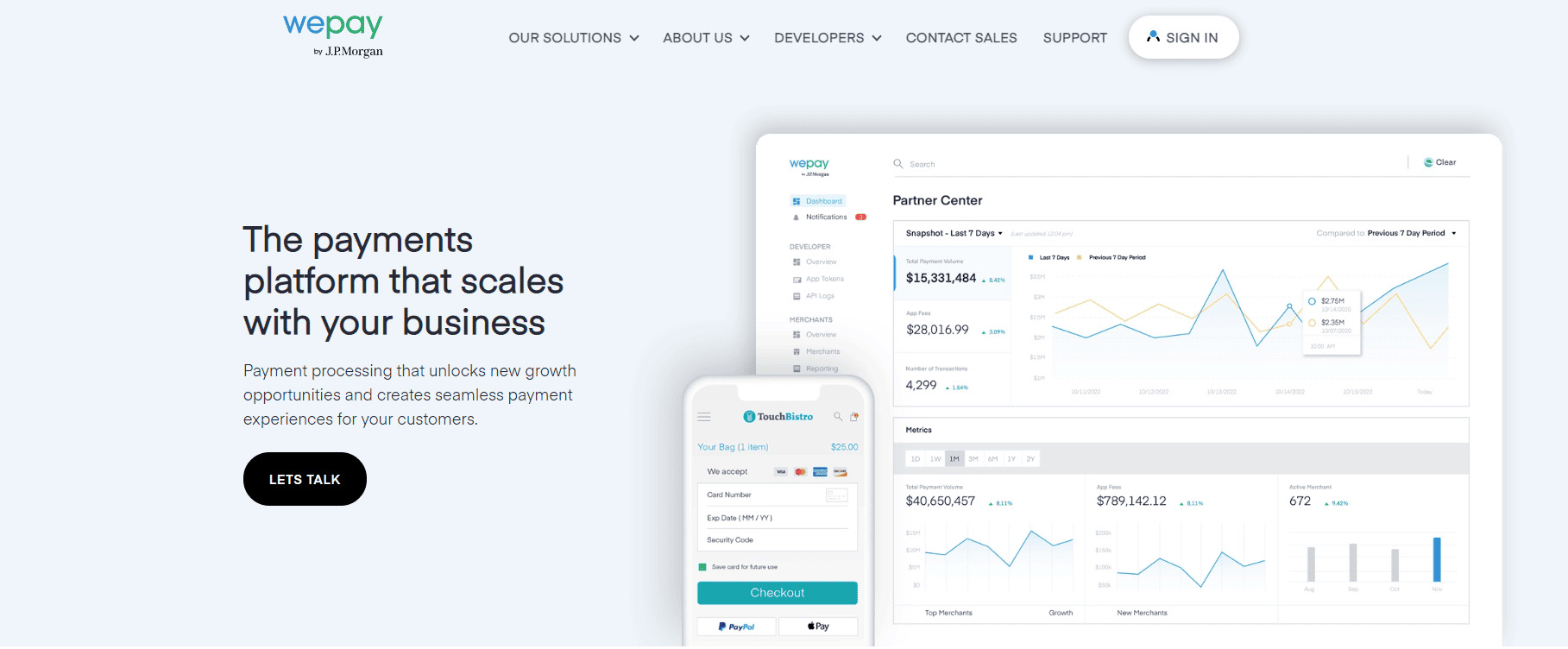Introduction
Welcome to our guide on understanding the WePay fee for Freshbooks. If you’re a Freshbooks user, you may be wondering how WePay benefits you and what the associated fees are. In this article, we will delve into the details of WePay and Freshbooks, explaining why this integration is valuable for users and how it can simplify your payment processes.
Managing payments and invoices can be a cumbersome task for freelancers, small businesses, and independent professionals. Freshbooks, a popular accounting software, streamlines this process by allowing you to create and send professional invoices, track expenses, and manage your financials all in one place. However, to complete the payment cycle, you need a reliable payment processor that seamlessly integrates with Freshbooks, and that’s where WePay comes in.
WePay is an online payment processor that specializes in providing secure and convenient payment solutions for businesses of all sizes. It takes away the hassle of managing multiple payment gateways and simplifies the invoicing and payment collection process. By integrating WePay with Freshbooks, you can seamlessly accept credit card payments, enhance your cash flow, and eliminate the need for manual reconciliation.
Now that we have a basic understanding of Freshbooks and WePay, let’s explore why Freshbooks users need to consider integrating WePay into their payment process.
What is WePay?
WePay is a reliable and secure online payment processor that enables businesses to accept credit card payments, process transactions, and manage their cash flow seamlessly. Founded in 2008, WePay has gained popularity for its user-friendly platform and robust security measures.
As an integrated payment provider, WePay offers a range of features that make it an ideal choice for businesses looking for a streamlined payment solution. Whether you’re a small business, freelancer, or nonprofit organization, WePay is designed to cater to your unique needs.
One of the key advantages of WePay is its ease of use. Setting up an account is simple, and the interface is intuitive, making it easy for businesses to navigate and manage their payments. With WePay, you can securely accept credit card payments, process transactions in real-time, and receive funds directly into your bank account.
In addition to its user-friendly interface, WePay prioritizes security. They employ advanced fraud detection tools and encryption technology to ensure the safety of your transactions and protect against fraudulent activities. This commitment to security has earned WePay a reputation as a trusted and reliable payment processor.
WePay also offers robust financial management tools that help businesses keep track of their cash flow. Through their comprehensive dashboard, you can monitor and analyze your transactions, generate reports, and gain valuable insights into your financial performance. This helps businesses make informed decisions and optimize their payment processes.
WePay understands the importance of seamless integration with existing systems. That’s why they offer a range of integrations with popular platforms, including Freshbooks. This integration allows businesses to streamline their payment processes and accept credit card payments directly within the Freshbooks platform.
In summary, WePay is an online payment processor that offers businesses a secure, user-friendly, and feature-rich solution for accepting credit card payments. With their robust security measures, financial management tools, and integrations with popular platforms like Freshbooks, WePay is a valuable payment processing option for businesses of all sizes.
What is Freshbooks?
Freshbooks is a cloud-based accounting software designed to simplify invoicing, expense tracking, and financial management for small businesses and self-employed professionals. It was founded in 2003 and has since become a popular choice for those seeking an efficient and user-friendly accounting solution.
With Freshbooks, users can create professional-looking invoices and easily customize them with their branding. The platform offers a range of templates to choose from, making it simple to create invoices that reflect your business’s image. Invoicing can be done quickly and easily, ensuring timely payment from clients and improving cash flow.
In addition to invoicing, Freshbooks provides tools for expense tracking and financial reporting. Users can easily categorize and track expenses, saving time and ensuring accurate financial records. The platform also generates reports that give businesses insights into their financial health, including profit and loss statements, balance sheets, and expense breakdowns.
Collaboration is an essential aspect of many businesses, and Freshbooks recognizes this. The software includes features that allow users to collaborate with team members, contractors, and clients. Users can invite team members to access and contribute to projects and track time spent on tasks. Freshbooks also allows for easy communication with clients, enabling them to view invoices, make payments, and provide feedback seamlessly.
Another noteworthy feature of Freshbooks is its mobile app. Available for both iOS and Android devices, the app allows users to manage their finances on the go. You can create and send invoices, track expenses, view reports, and even accept payments, all from the convenience of your mobile device.
Freshbooks’ commitment to user satisfaction extends to its extensive integrations. The software integrates with various third-party applications, allowing users to streamline their workflow and automate tasks. Some of the popular integrations include project management tools, CRM systems, payment gateways, and time-tracking software, providing users with a comprehensive and interconnected ecosystem.
In summary, Freshbooks is an intuitive and feature-rich accounting software that simplifies invoicing, expense tracking, and financial management for small businesses and self-employed professionals. Its user-friendly interface, collaboration features, mobile app, and wide range of integrations make it a valuable tool for those seeking an efficient and streamlined accounting solution.
Why do Freshbooks users need WePay?
Freshbooks is already a powerful accounting software that provides users with a wide range of features to manage their finances. However, when it comes to collecting payments, Freshbooks relies on integrated payment processors like WePay to ensure a seamless and secure payment experience for users. So why do Freshbooks users need WePay? Let’s explore the reasons below.
1. Simplified Payment Collection: WePay integration allows Freshbooks users to accept credit card payments directly within the Freshbooks platform. This eliminates the need for manual invoice reconciliation and simplifies the payment collection process. Users no longer have to redirect clients to external payment gateways, enhancing the overall user experience.
2. Seamless Integration: WePay seamlessly integrates with Freshbooks, meaning you can create and send invoices to clients and have them pay directly through WePay. The information from the payment transaction is automatically synced with your Freshbooks account, allowing for effortless payment tracking and reconciliation.
3. Enhanced Cash Flow: With WePay, businesses can receive their payments faster, resulting in improved cash flow. Clients can make credit card payments directly within the Freshbooks platform, reducing the time it takes for payments to reach your bank account. This helps to minimize payment delays and ensure a steady inflow of funds.
4. Security and Fraud Protection: WePay prioritizes the security of user transactions, employing robust fraud detection tools and encryption technology. By using WePay as a payment processor, Freshbooks users can have peace of mind knowing that their clients’ sensitive payment information is protected against fraudulent activities.
5. Professional Image: Accepting credit card payments through WePay adds professionalism to your business. It allows you to offer clients a more convenient payment option and demonstrates that you are serious about providing a seamless and secure transaction experience.
6. Customer Convenience: WePay offers a user-friendly payment interface, making it easy for clients to submit payments. Clients can use their preferred credit card to complete the transaction, making the payment process more convenient and hassle-free for them.
In summary, Freshbooks users need WePay to simplify their payment collection process, enhance cash flow, improve security, and provide a professional payment experience for their clients. Integrating WePay with Freshbooks ensures that businesses can effectively manage their invoicing and receive payments seamlessly within the Freshbooks platform.
How does WePay work with Freshbooks?
WePay and Freshbooks work together to provide a seamless payment processing solution for businesses. The integration allows users to accept credit card payments directly within the Freshbooks platform, streamlining the payment collection process. Let’s dive into how WePay works with Freshbooks.
1. Setting Up the Integration: To get started, Freshbooks users need to set up a WePay account and link it to their Freshbooks account. This typically involves providing some basic information about your business and connecting the two accounts through an API integration.
2. Creating Invoices: Once the integration is set up, you can create and send invoices to your clients using Freshbooks. When creating an invoice, you have the option to include a “Pay Now” button that allows clients to make payment directly through WePay.
3. Client Payment Process: When a client receives the invoice, they have the option to click on the “Pay Now” button. This will redirect them to the WePay payment page, where they can securely enter their credit card information and complete the transaction.
4. Real-Time Payment Status: Once the payment is made, the transaction status is automatically updated in both Freshbooks and WePay. This real-time synchronization allows you to track payment status and reconcile invoices with ease.
5. Payment Confirmation and Notification: After the successful payment, both you and your client will receive payment confirmation notifications. This ensures transparency and provides peace of mind for both parties.
6. Automatic Reconciliation: WePay and Freshbooks work together to simplify the reconciliation process. The payment information from WePay is automatically synced with your Freshbooks account, allowing you to easily match payments with the corresponding invoices.
7. Financial Reporting: WePay provides detailed transaction reports that can be accessed within the Freshbooks platform. These reports give you valuable insights into your payment history, allowing you to analyze financial performance and make informed business decisions.
8. Refunds and Disputes: In the event of a refund or dispute, WePay provides a streamlined process within the Freshbooks platform. This saves you time and effort by handling disputes or issuing refunds directly through the integrated system.
In summary, WePay works seamlessly with Freshbooks to simplify the payment collection process. By integrating WePay into Freshbooks, businesses can create professional invoices and accept credit card payments directly within the platform. This streamlines the payment process, provides real-time transaction status updates, and automates reconciliation. The integration between WePay and Freshbooks ensures a secure, efficient, and user-friendly experience for both businesses and their clients.
What is the fee for using WePay with Freshbooks?
When using WePay as a payment processor with Freshbooks, there are fees associated with processing transactions. It’s important to understand these fees to accurately budget and manage your finances. Let’s take a closer look at the fees for using WePay with Freshbooks.
WePay charges a transaction fee for processing payments made through their platform. The fee is based on a percentage of each transaction and may vary depending on the type of payment being processed.
The fee for using WePay with Freshbooks is currently set at 2.9% + $0.30 per transaction. This means that for every payment processed through WePay, you will be charged 2.9% of the transaction amount, plus an additional $0.30.
For example, if you receive a payment of $100 through WePay, the fee would be calculated as follows: 2.9% of $100 is $2.90, plus the additional $0.30, resulting in a total fee of $3.20. This means that you would receive $96.80 in your account.
It’s important to note that this fee structure applies to all credit card transactions processed through WePay, regardless of the card type (Visa, Mastercard, American Express, etc.). However, fees for e-check (ACH) payments may be different and could vary depending on the specific agreement you have with WePay.
While the transaction fee is generally standard across the industry, it’s essential to factor it into your pricing and financial planning. It’s also worth noting that the fees associated with using WePay are competitive compared to other popular payment processors.
Lastly, it’s important to remember that WePay’s fees for using their platform with Freshbooks are subject to change. It’s advisable to regularly check for any updates in the fee structure to ensure you have accurate information when budgeting for payment processing.
In summary, the fee for using WePay with Freshbooks is currently set at 2.9% + $0.30 per transaction. This transaction fee is applied to all credit card transactions processed through WePay. It’s essential to keep this fee in mind when managing your finances and pricing your products or services accordingly.
How is the WePay fee calculated?
The WePay fee is calculated based on a percentage of the transaction amount, along with a fixed fee per transaction. Understanding how this fee is calculated is crucial for businesses using WePay with Freshbooks. Let’s explore how the WePay fee is calculated in more detail.
The current fee structure for using WePay with Freshbooks is 2.9% + $0.30 per transaction. This means that WePay charges a percentage fee of 2.9% of the transaction amount, in addition to a fixed fee of $0.30 for each transaction processed.
To calculate the WePay fee for a specific transaction, you’ll need to apply the following formula:
Transaction Fee = (Transaction Amount * 0.029) + $0.30
For example, let’s say you receive a payment of $100 through WePay. To calculate the WePay fee, you would multiply the transaction amount by 0.029 (2.9%) and add $0.30:
(100 * 0.029) + $0.30 = $2.90 + $0.30 = $3.20
In this example, the WePay fee for the $100 transaction would be $3.20. This means that you would receive $96.80 in your account after deducting the fee.
It’s important to note that the WePay fee structure may vary based on factors such as the type of payment (credit card, e-check), the industry, and specific agreements with WePay. Therefore, always refer to the most up-to-date fee structure provided by WePay to ensure accurate calculations for your transactions.
Additionally, it’s worth noting that the WePay fee is applied to the transaction amount only and does not include any taxes or other additional charges associated with the transaction.
In summary, the WePay fee is calculated based on a percentage of the transaction amount (2.9%) and a fixed fee per transaction ($0.30). By applying the appropriate formula, businesses can accurately calculate the WePay fee for each transaction processed through WePay with Freshbooks.
Comparing the WePay fee to other payment processors
When choosing a payment processor for your business, it’s important to consider the fees associated with each option. Comparing the WePay fee to other payment processors can help you make an informed decision. Let’s take a look at how the WePay fee stacks up against other popular payment processors.
WePay’s fee structure of 2.9% + $0.30 per transaction is in line with the industry standard. Many other payment processors, such as PayPal and Stripe, also offer similar fee structures for credit card transactions.
PayPal, for example, charges a fee of 2.9% + $0.30 per transaction for domestic payments. If you’re selling goods or services internationally, the fee may be slightly higher. Stripe also offers a comparable fee structure of 2.9% + $0.30 per successful transaction.
When comparing the WePay fee to other payment processors, it’s important to consider any additional fees that may apply. Some payment processors may charge additional fees for features like chargebacks, refunds, or international transactions. WePay, along with other payment processors, may have separate fees for these additional services.
Another aspect to consider when comparing fees is the ease of integration with your accounting software. WePay’s integration with Freshbooks allows for seamless payment collection and synchronization of payment data. This level of integration and convenience may outweigh slight differences in fee structures when choosing a payment processor.
Additionally, it’s important to consider the overall value and features offered by each payment processor. Evaluate factors such as security measures, customer support, mobile compatibility, and additional integrations. While the fee structure is an essential consideration, it is not the sole factor in determining the best payment processor for your business.
Ultimately, the choice of payment processor will depend on your business’s specific needs and priorities. It’s important to carefully review the fee structures, compare them to your expected transaction volume, and consider the overall value provided by each payment processor.
In summary, the WePay fee of 2.9% + $0.30 per transaction is comparable to other payment processors in the industry, such as PayPal and Stripe. When comparing fees, it’s essential to consider additional charges, ease of integration, and the overall value provided by each payment processor. By evaluating these factors, you can choose the payment processor that best aligns with your business’s needs and goals.
Are there any additional fees?
While the WePay fee for using their payment processing service with Freshbooks is 2.9% + $0.30 per transaction, it’s important to be aware of any additional fees that may apply. Understanding these potential additional fees can help you accurately budget and manage your finances. Let’s take a closer look at whether there are any additional fees when using WePay with Freshbooks.
1. Chargeback Fees: When a customer disputes a transaction and initiates a chargeback, there may be additional fees involved. WePay may charge a fee for every chargeback that occurs. This fee is typically in addition to any funds that need to be refunded to the customer.
2. International Transaction Fees: If you’re processing payments from clients located outside of your country, additional fees may apply. WePay, like many payment processors, may charge extra for international transactions. These fees are typically a percentage of the transaction amount and may vary depending on the countries involved.
3. E-check (ACH) Fees: While the 2.9% + $0.30 fee structure primarily applies to credit card transactions, fees for e-check (ACH) payments may be different. WePay may have separate fees for e-check payments, and these fees may vary depending on factors such as the transaction amount and the country in which your business is based.
4. Account Maintenance Fees: WePay may also have certain account maintenance fees, although these are typically minimal and may be charged on a monthly or annual basis. These fees may cover services such as account administration, account access, or technical support.
It’s important to note that the specific fees and their amounts may vary based on your agreement with WePay and the country in which your business is located. Therefore, it’s advisable to review the most up-to-date fee structure and terms of service provided by WePay to ensure accurate information regarding any potential additional fees.
Additionally, it’s crucial to consider the overall value and features offered by WePay and Freshbooks when evaluating the fee structure. Ensure that the services provided align with your business needs and justify the costs associated with the payment processing.
In summary, while the main fee for using WePay with Freshbooks is 2.9% + $0.30 per transaction, it’s essential to be aware of potential additional fees. These may include chargeback fees, international transaction fees, e-check fees, and account maintenance fees. Consult the latest fee structure provided by WePay to fully understand any additional fees that may apply when using WePay as your payment processor with Freshbooks.
How to set up WePay with Freshbooks
Setting up WePay with Freshbooks is a straightforward process that involves linking your WePay account to your Freshbooks account. Follow these steps to get started:
1. Create a WePay Account: If you don’t already have a WePay account, visit the WePay website and sign up for an account. Provide the necessary information about your business and set up your account credentials.
2. Log in to Freshbooks: Log in to your Freshbooks account using your credentials. Once logged in, navigate to the “Payments” section.
3. Connect WePay: Within the “Payments” section, locate the option to connect a payment gateway. Select WePay from the available options.
4. Provide WePay Account Details: You’ll be prompted to enter your WePay account details. Provide the required information, such as your WePay account email or username, and any other requested information.
5. Verify WePay Account: Follow the verification steps provided by Freshbooks to establish the connection between your WePay and Freshbooks accounts. This may include confirming your account through email or completing additional verification processes as requested.
6. Configure WePay Settings: Once your WePay account is successfully linked, you’ll have the option to configure various settings within Freshbooks. Customization options may include setting up email notifications, specifying tax settings, and selecting preferred currency options.
7. Test Transactions: After configuring the settings, it’s a good practice to test the payment process. Create a test invoice within Freshbooks and process a transaction using the WePay payment option. This will allow you to verify that payments are being processed correctly and that the synchronization between Freshbooks and WePay is functioning as expected.
8. Start Accepting Payments: Once you’ve successfully tested the integration, you’re ready to start accepting payments through WePay within Freshbooks. Create and send invoices to your clients, including the option for them to make payments through WePay. Funds received will be deposited into your WePay account and automatically recorded within Freshbooks.
Remember to review the terms of service and any additional requirements or restrictions set by WePay during the setup process. It’s important to stay compliant with WePay’s policies and guidelines to ensure uninterrupted payment processing functionality.
In summary, setting up WePay with Freshbooks involves creating a WePay account, linking it to your Freshbooks account, configuring the settings, and testing the payment process. By following these steps, you can seamlessly integrate WePay into your Freshbooks account and start accepting payments efficiently and securely.
Conclusion
The integration between WePay and Freshbooks provides a streamlined and efficient payment processing solution for businesses, freelancers, and self-employed professionals. By understanding the WePay fee structure, comparing it to other payment processors, and considering any additional fees, you can make informed decisions about using WePay with Freshbooks.
WePay offers a user-friendly interface, robust security measures, and seamless integration with Freshbooks, allowing businesses to simplify their payment collection process and enhance their cash flow. The fee for using WePay with Freshbooks is currently set at 2.9% + $0.30 per transaction, which is in line with industry standards and competitive with other payment processors.
When setting up WePay with Freshbooks, it’s important to follow the necessary steps to link your accounts, configure the settings, and test the payment process. By doing so, you can start accepting credit card payments within the Freshbooks platform, improving the overall user experience and streamlining your financial management process.
Remember to regularly review the terms of service, fee structures, and any updates provided by WePay to stay informed about potential changes and ensure accurate financial planning. Continuously evaluating the value and features offered by WePay, as well as your specific business needs, will help you make the best decision when choosing a payment processor.
In summary, integrating WePay with Freshbooks offers businesses a secure, efficient, and user-friendly payment processing solution. By understanding the fees, comparing them to other processors, and following the setup steps, businesses can benefit from seamless payment collection, improved cash flow, and simplified financial management.

























